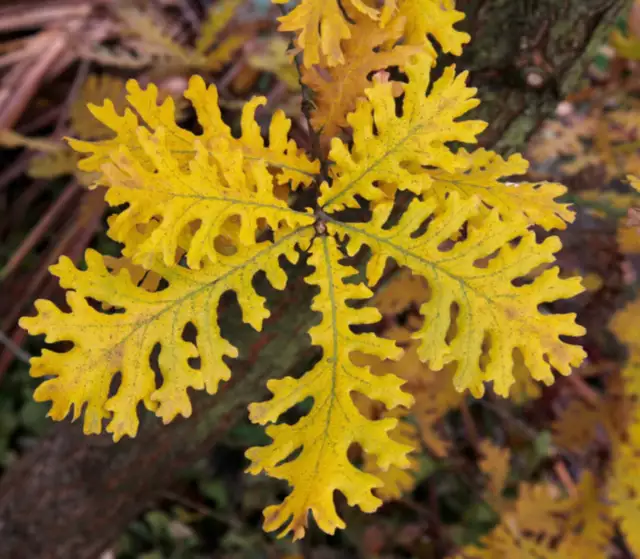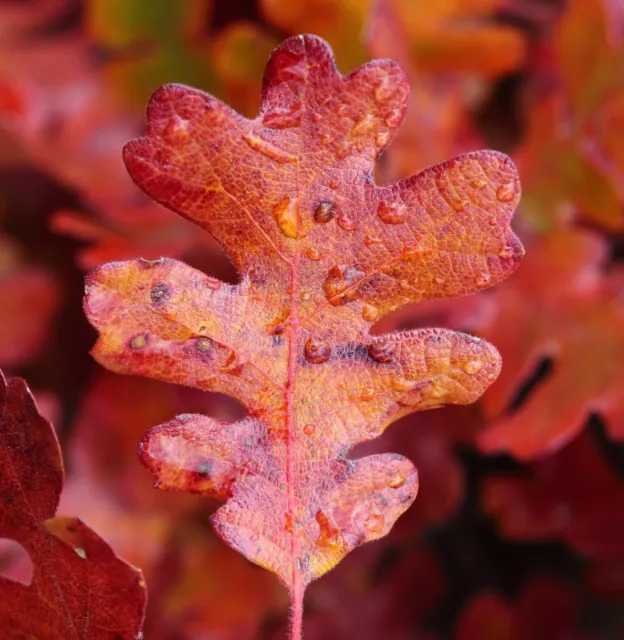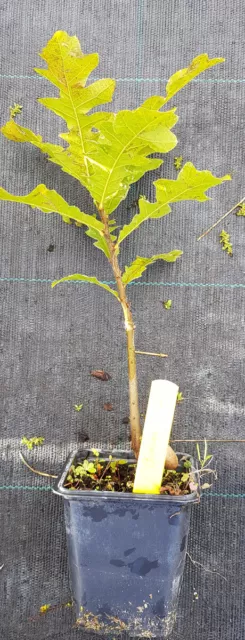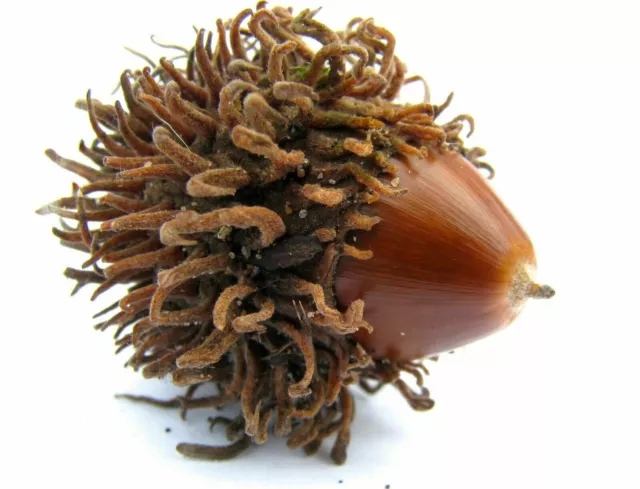Quercus cerris
Quercus cerris
Quercus cerris, commonly known as Turkey oak, is a species of oak native to southeastern Europe and Asia Minor. It belongs to the Fagaceae family, which includes other well-known oak species such as Quercus robur (English oak) and Quercus alba (white oak). Turkey oak is a deciduous tree that is valued for its ornamental beauty, sturdy growth habit, and adaptability to a variety of soil types and environmental conditions. Size: Turkey oak typically grows to a height of 20-30 meters (65-100 feet) tall, although it can occasionally reach heights of up to 40 meters (130 feet). Trunk: The trunk of Quercus cerris is often straight and robust, with a diameter ranging from 1 to 1.5 meters (3-5 feet). Leaves: The leaves are alternate, simple, and ovate to oblong in shape, measuring 7-15 cm (3-6 inches) in length. They have deep lobes with bristle-tipped teeth along the margins and are glossy dark green on the upper surface, paler and sometimes hairy underneath. Bark: The bark of younger trees is smooth and greyish-brown, becoming fissured and scaly with age. Flowers: The tree produces inconspicuous flowers in spring, typically in April to May. Male flowers are borne in pendulous catkins, while female flowers are solitary or clustered in the leaf axils. Fruit: The fruit is an acorn, usually about 2-3 cm (0.8-1.2 inches) long, with a cupule that encloses about a third to half of the nut. Acorns take about 18 months to mature, and they ripen in the fall. Habitat and Range: Quercus cerris is native to southeastern Europe and Asia Minor, including countries such as Greece, Italy, Turkey, and Bulgaria. It is often found in mixed forests, open woodlands, and along forest edges. The tree is adaptable to a wide range of soil types, from sandy loam to clay, and it can tolerate both acidic and alkaline soils. Cultivation: 1. Location: Choose a sunny or partially shaded location for planting Turkey oak. It prefers full sun but can tolerate some shade. Ensure adequate spacing, as Turkey oak trees can grow quite large. Plant them at least 10-15 meters (30-50 feet) apart to allow for proper growth and development. 2. Soil: Quercus cerris is adaptable to various soil types but thrives in well-drained, fertile soils. Amend heavy clay soils with organic matter such as compost to improve drainage and soil structure. The pH level of the soil should ideally be neutral to slightly acidic. 3. Watering: While Turkey oak is drought-tolerant once established, it benefits from regular watering, especially during dry periods. Water newly planted trees deeply and frequently to help establish a strong root system. 4. Pruning: Minimal pruning is typically required for Turkey oak, especially when grown in a natural or woodland setting. Remove any dead, diseased, or damaged branches as needed to maintain the tree's health and appearance. 5. Fertilization: Turkey oak usually does not require regular fertilization, especially if planted in fertile soils. However, you can apply a balanced fertilizer in early spring to promote healthy growth, following the manufacturer's recommendations. 6. Pest and Disease Management: Turkey oak is generally resistant to pests and diseases, but it may occasionally be affected by oak wilt, powdery mildew, or oak leaf blister. Monitor the tree regularly for signs of pests or diseases, and take appropriate measures such as pruning infected branches or applying fungicides if necessary. 7. Mulching: Apply a layer of organic mulch, such as wood chips or shredded bark, around the base of the tree to conserve moisture, suppress weed growth, and improve soil health. Keep the mulch several inches away from the trunk to prevent moisture buildup and potential rot. Quercus cerris, or Turkey oak, is a beautiful and resilient tree that can enhance the landscape with its attractive foliage, sturdy growth habit, and adaptability to various growing conditions. By following these cultivation tips, you can successfully grow and maintain Turkey oak trees in your garden, park, or woodland area, adding beauty and biodiversity to the environment. IMPORTANT: Please be aware that picture 1 show adult plant not for sale, the offer is for a plant in the dimension indicated product description.
Quercus cerris
Quercus cerris, commonly known as Turkey oak, is a species of oak native to southeastern Europe and Asia Minor. It belongs to the Fagaceae family, which includes other well-known oak species such as Quercus robur (English oak) and Quercus alba (white oak). Turkey oak is a deciduous tree that is valued for its ornamental beauty, sturdy growth habit, and adaptability to a variety of soil types and environmental conditions.
- Size: Turkey oak typically grows to a height of 20-30 meters (65-100 feet) tall, although it can occasionally reach heights of up to 40 meters (130 feet).
- Trunk: The trunk of Quercus cerris is often straight and robust, with a diameter ranging from 1 to 1.5 meters (3-5 feet).
- Leaves: The leaves are alternate, simple, and ovate to oblong in shape, measuring 7-15 cm (3-6 inches) in length. They have deep lobes with bristle-tipped teeth along the margins and are glossy dark green on the upper surface, paler and sometimes hairy underneath.
- Bark: The bark of younger trees is smooth and greyish-brown, becoming fissured and scaly with age.
- Flowers: The tree produces inconspicuous flowers in spring, typically in April to May. Male flowers are borne in pendulous catkins, while female flowers are solitary or clustered in the leaf axils.
- Fruit: The fruit is an acorn, usually about 2-3 cm (0.8-1.2 inches) long, with a cupule that encloses about a third to half of the nut. Acorns take about 18 months to mature, and they ripen in the fall.
Habitat and Range:
- Quercus cerris is native to southeastern Europe and Asia Minor, including countries such as Greece, Italy, Turkey, and Bulgaria.
- It is often found in mixed forests, open woodlands, and along forest edges.
- The tree is adaptable to a wide range of soil types, from sandy loam to clay, and it can tolerate both acidic and alkaline soils.
Cultivation:
1. Location:
- Choose a sunny or partially shaded location for planting Turkey oak. It prefers full sun but can tolerate some shade.
- Ensure adequate spacing, as Turkey oak trees can grow quite large. Plant them at least 10-15 meters (30-50 feet) apart to allow for proper growth and development.
2. Soil:
- Quercus cerris is adaptable to various soil types but thrives in well-drained, fertile soils.
- Amend heavy clay soils with organic matter such as compost to improve drainage and soil structure.
- The pH level of the soil should ideally be neutral to slightly acidic.
3. Watering:
- While Turkey oak is drought-tolerant once established, it benefits from regular watering, especially during dry periods.
- Water newly planted trees deeply and frequently to help establish a strong root system.
4. Pruning:
- Minimal pruning is typically required for Turkey oak, especially when grown in a natural or woodland setting.
- Remove any dead, diseased, or damaged branches as needed to maintain the tree's health and appearance.
5. Fertilization:
- Turkey oak usually does not require regular fertilization, especially if planted in fertile soils.
- However, you can apply a balanced fertilizer in early spring to promote healthy growth, following the manufacturer's recommendations.
6. Pest and Disease Management:
- Turkey oak is generally resistant to pests and diseases, but it may occasionally be affected by oak wilt, powdery mildew, or oak leaf blister.
- Monitor the tree regularly for signs of pests or diseases, and take appropriate measures such as pruning infected branches or applying fungicides if necessary.
7. Mulching:
- Apply a layer of organic mulch, such as wood chips or shredded bark, around the base of the tree to conserve moisture, suppress weed growth, and improve soil health.
- Keep the mulch several inches away from the trunk to prevent moisture buildup and potential rot.
1. Location:
- Choose a sunny or partially shaded location for planting Turkey oak. It prefers full sun but can tolerate some shade.
- Ensure adequate spacing, as Turkey oak trees can grow quite large. Plant them at least 10-15 meters (30-50 feet) apart to allow for proper growth and development.
2. Soil:
- Quercus cerris is adaptable to various soil types but thrives in well-drained, fertile soils.
- Amend heavy clay soils with organic matter such as compost to improve drainage and soil structure.
- The pH level of the soil should ideally be neutral to slightly acidic.
3. Watering:
- While Turkey oak is drought-tolerant once established, it benefits from regular watering, especially during dry periods.
- Water newly planted trees deeply and frequently to help establish a strong root system.
4. Pruning:
- Minimal pruning is typically required for Turkey oak, especially when grown in a natural or woodland setting.
- Remove any dead, diseased, or damaged branches as needed to maintain the tree's health and appearance.
5. Fertilization:
- Turkey oak usually does not require regular fertilization, especially if planted in fertile soils.
- However, you can apply a balanced fertilizer in early spring to promote healthy growth, following the manufacturer's recommendations.
6. Pest and Disease Management:
- Turkey oak is generally resistant to pests and diseases, but it may occasionally be affected by oak wilt, powdery mildew, or oak leaf blister.
- Monitor the tree regularly for signs of pests or diseases, and take appropriate measures such as pruning infected branches or applying fungicides if necessary.
7. Mulching:
- Apply a layer of organic mulch, such as wood chips or shredded bark, around the base of the tree to conserve moisture, suppress weed growth, and improve soil health.
- Keep the mulch several inches away from the trunk to prevent moisture buildup and potential rot.
- Quercus cerris is adaptable to various soil types but thrives in well-drained, fertile soils.
- Amend heavy clay soils with organic matter such as compost to improve drainage and soil structure.
- The pH level of the soil should ideally be neutral to slightly acidic.
3. Watering:
- While Turkey oak is drought-tolerant once established, it benefits from regular watering, especially during dry periods.
- Water newly planted trees deeply and frequently to help establish a strong root system.
4. Pruning:
- Minimal pruning is typically required for Turkey oak, especially when grown in a natural or woodland setting.
- Remove any dead, diseased, or damaged branches as needed to maintain the tree's health and appearance.
5. Fertilization:
- Turkey oak usually does not require regular fertilization, especially if planted in fertile soils.
- However, you can apply a balanced fertilizer in early spring to promote healthy growth, following the manufacturer's recommendations.
6. Pest and Disease Management:
- Turkey oak is generally resistant to pests and diseases, but it may occasionally be affected by oak wilt, powdery mildew, or oak leaf blister.
- Monitor the tree regularly for signs of pests or diseases, and take appropriate measures such as pruning infected branches or applying fungicides if necessary.
7. Mulching:
- Apply a layer of organic mulch, such as wood chips or shredded bark, around the base of the tree to conserve moisture, suppress weed growth, and improve soil health.
- Keep the mulch several inches away from the trunk to prevent moisture buildup and potential rot.
- Minimal pruning is typically required for Turkey oak, especially when grown in a natural or woodland setting.
- Remove any dead, diseased, or damaged branches as needed to maintain the tree's health and appearance.
5. Fertilization:
- Turkey oak usually does not require regular fertilization, especially if planted in fertile soils.
- However, you can apply a balanced fertilizer in early spring to promote healthy growth, following the manufacturer's recommendations.
6. Pest and Disease Management:
- Turkey oak is generally resistant to pests and diseases, but it may occasionally be affected by oak wilt, powdery mildew, or oak leaf blister.
- Monitor the tree regularly for signs of pests or diseases, and take appropriate measures such as pruning infected branches or applying fungicides if necessary.
7. Mulching:
- Apply a layer of organic mulch, such as wood chips or shredded bark, around the base of the tree to conserve moisture, suppress weed growth, and improve soil health.
- Keep the mulch several inches away from the trunk to prevent moisture buildup and potential rot.
- Turkey oak is generally resistant to pests and diseases, but it may occasionally be affected by oak wilt, powdery mildew, or oak leaf blister.
- Monitor the tree regularly for signs of pests or diseases, and take appropriate measures such as pruning infected branches or applying fungicides if necessary.
7. Mulching:
- Apply a layer of organic mulch, such as wood chips or shredded bark, around the base of the tree to conserve moisture, suppress weed growth, and improve soil health.
- Keep the mulch several inches away from the trunk to prevent moisture buildup and potential rot.
Quercus cerris, or Turkey oak, is a beautiful and resilient tree that can enhance the landscape with its attractive foliage, sturdy growth habit, and adaptability to various growing conditions. By following these cultivation tips, you can successfully grow and maintain Turkey oak trees in your garden, park, or woodland area, adding beauty and biodiversity to the environment.
IMPORTANT: Please be aware that picture 1 show adult plant not for sale, the offer is for a plant in the dimension indicated product description.
Disclaimers and important info
| Plants: Pictures | Keep on mind that the plant may have grown since pictured. |
| Plants: Seasonality | Be aware that most plants change across seasons. If present foliage could have been fallen or change in its color. |
| Plants: Shipment | Plants will be sent bare roots and with no soil. |
| Plants: Phytosanitary Certificates | A phytosanitary certificate (for additional costs of 20,00 EURO) is necessary for export plants from Italy to ALL destinations out of EUROPEAN COMMUNITY. Among which: United Kingdom Turkey, South America, USA, Canada, Australia, Japan, Singapore, Philippines, South Korea, Thailand, etcetera. You can buy it in our eBay store. 1 single certificate can cover several plants purchase that are sent together in same shipment. If you will not buy the certificate and the plants, we will not be responsible for any capture by customs of destination. |
| Plants: Recognition and Nomenclature | Plants nomenclature has been done at our best knowledge, please see picture to see the product. |
| Seeds: Legal Purchases | We ship worldwide but please be sure that the seeds are legal in your country. We will not accept any claims in case the seeds are confiscated by your local authorities |
| Seeds: Shipment | Seeds are clean and each species is handled in a transparent small bag. Latin names of nomenclature are indicated in each bag of seeds. |
Additional Pictures
×
Tell a friend
Visit store
Watch now
Postage info
Click the Postage tab above the listing description for more info
Click the Postage tab above the listing description for more info!
Additional delivery notes
PICK UP OPTION
Sorry, our items are NOT available for pick-up.
PAYING VIA PAYPAL |
We accept PayPal on our all our items so you can shop with confidence.
Simple choose the PayPal option when proceeding through the checkout.
Additional Information
No additional information at this time
Ask seller a question
You might also like
Copiapoa tenuissima GG7
Astrophytum cv ONZUKA x SUPERKABUTO NN77
Capsicum pubescens "rocoto" SEEDS
Encephalartos horridus 4cm CAUDEX
Contact
Astrophytum cv ONZUKA x SUPERKABUTO NN77
Capsicum pubescens "rocoto" SEEDS
Encephalartos horridus 4cm CAUDEX
Contact
Encephalartos horridus 4cm CAUDEX Contact
To contact our Customer Service Team, simply click the button here and our Customer Service team will be happy to assist.
Ask seller a question
© Botanical Archive
PostageClick the Postage tab above the listing description for more info
PaymentAccepted Payment Methods
- PayPal
Returns are accepted
Items must be returned within 30 days of the auction ending
Buyer will pay for return shipping.
eBay integration by- Size: 20-40cm
- Brand: Botanical Archive
PicClick Insights - Quercus cerris PicClick Exclusif
- Popularité - 0 personnes suivent la vente, 0.0 de nouvelles personnes suivent la vente par jour, 59 days for sale on eBay. 0 vendu, 4 disponibles.
- Meilleur Prix -
- Vendeur - 24.873+ articles vendu. 2.1% évaluations négative. Bon vendeur avec bonne rétroaction positive et bonne quantité de cotes.
Les Gens ont Aussi Aimé PicClick Exclusif

Quercus gussonei
EUR 15,00 Achat immédiat 1d 2h
Quercus frainetto
EUR 37,00 Achat immédiat 1d 2h
Quercus garryana (Vancouver island)
EUR 20,00 Achat immédiat 1d 2h 1 personne suit la vente
1 personne suit la venteQuercus cerris / Chêne chevelu de Bourgogne / Godet
EUR 10,78 Achat immédiat
Quercus cerris (1 Plante A40-5x6, 5x15
EUR 10,80 Achat immédiat ou Offre directe
1 de Plante Quercus cerris 20-40cm Chêne à Partir De Liège
EUR 12,00 Achat immédiat ou Offre directe
Zerreiche (Quercus Cerris) Zirneiche Chromo-Lithographie De 1882 Autrichien
EUR 9,53 Achat immédiat
